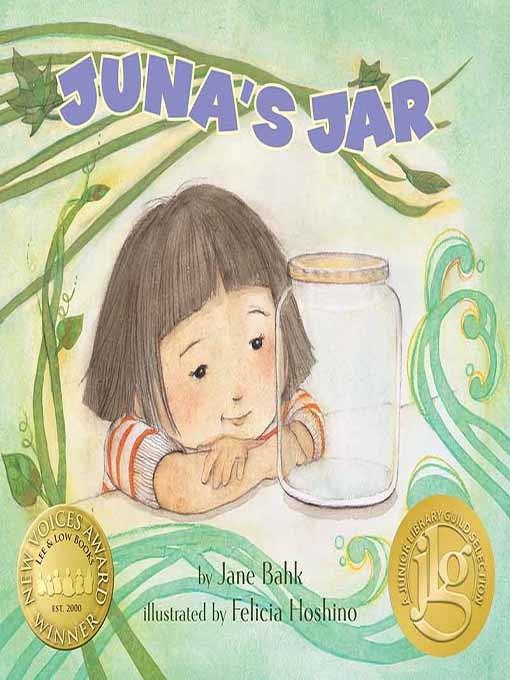
Juna's Jar
فرمت کتاب
ebook
تاریخ انتشار
2014
Lexile Score
540
Reading Level
2-3
ATOS
3.4
Interest Level
K-3(LG)
نویسنده
Felicia Hoshinoناشر
Lee & Low Booksشابک
9781620142172
کتاب های مرتبط
- اطلاعات
- نقد و بررسی
- دیدگاه کاربران
نقد و بررسی

October 20, 2014
A girl named Juna gets significant mileage—in more ways than one—out of an empty jar of kimchi in Bahk’s debut, which won the publisher’s New Voices Award. Juna is distraught after her friend Hector moves away suddenly; to cheer her up, her brother gets her a small fish, which she keeps in her jar. At night, “when everyone else was asleep,” Juna joins the fish on an imaginary underwater journey, and in the morning, “Juna’s fish had grown so big its mouth nearly touched its tail.” This surprising development sets the state for subsequent “was it really just a dream?” adventures, which eventually let Juna make peace with Hector’s absence. Hoshino (Sora and the Cloud) contributes warm watercolors, dominated by pale yellows and greens, that bring Juna’s nighttime sojourns to full life—in the final one, she dons aviator goggles and flies over a bustling city on the back of a cricket. Despite the elements of magical realism interwoven with the plot, Bahk never loses sight of the very real emotions that drive her pensive, curious, and openhearted heroine. Ages 5–9.

November 1, 2014
A seemingly ordinary kimchi jar is anything but in this gentle tale of old friends and new. Best friends Juna and Hector collect rocks and bugs in her family's empty kimchi jars. One day, Juna goes to Hector's apartment only to learn from his abuela that his parents came and took him to live with them far away. To cheer her up, Juna's brother buys her a fish to place in the empty kimchi jar. That night, she dreams of questing underwater for Hector, only to awaken to find her pet has, remarkably, grown too big for its home. She turns the now-empty jar into a terrarium with a small bean plant, and that night she imagines she is looking for Hector through a rain forest. This pattern is repeated again with a cricket, and then finally Juna is able to come to terms with Hector's absence and is emotionally ready to make another friend. The steady narrative repetition as Juna sleeps and seeks offers a reassuring pattern for children who might be missing their own Hectors. The logic (or magic) behind the jar's occupants' phenomenal growth is unclear, and Juna's brother never remarks on its impossibility; less-credulous readers will wonder about this. Meanwhile, the muted tones of Hoshino's watercolors soothe and, on occasion, amuse, as when readers witness the slightly smooshed lips of Juna enduring a hug she did not seek. While a little logically shaky, this fills a need for those children who find themselves adrift when their closest friends seemingly disappear. (Picture book. 4-7)
COPYRIGHT(2014) Kirkus Reviews, ALL RIGHTS RESERVED.

December 1, 2014
PreS-Gr 2-Charming soft watercolor illustrations and a sweet story that tugs at the imagination provide a flight of fancy that youngsters will enjoy hearing again and again. Little Juna and her friend Hector share adventures in the park across the street from their apartment building in Koreatown. Interesting critters and other items go into Juna's empty kimchi jar to be studied, then released. When Hector moves away, Juna's older brother, Minho, observing her sadness, buys her a small fish, gives her a small bean plant grown at school, then helps her find twigs and leaves in the park to provide a habitat for a cricket. Each night, the kimchi jar takes Juna on a fabulous journey. The goldfish takes her on an undersea adventure, growing so large that it must be transferred to the family aquarium. The bean plant transports her to a tropical rainforest, then is moved to a large pot on the balcony; the cricket carries Juna over city buildings to the window of Hector's bedroom, where his stone-filled kimchi jar sits on a windowsill near his bed. Seeing Hector safe and happy allows Juna to move on and make a new friend at the park. Hoshino's delightful detail-filled paintings of Juna's nighttime adventures show smiling sea creatures, sloths, monkeys and crocodiles, and a city alive with activity, illuminated by vehicle headlights "that lit up the hill like a string of holiday lights." Use this title inpreschool storytimes or in the classroom to stimulate leaps of imagination.-Susan Scheps, formerly at Shaker Public Library, OH
Copyright 2014 School Library Journal, LLC Used with permission.

February 1, 2015
Preschool-G Losing a best friend is never easy, especially when there isn't a chance to say good-bye. Juna and Hector use her empty kimchi jars to collect rocks and bugs, but when Hector suddenly moves far away, Juna's jar seems especially bare. Her brother tries to help by getting her a fish to keep in the jar, and then, that night, Juna dreams of diving into the ocean and searching for Hector. The next night, a similar dream, set in a rain forest, involves Juna's brother giving her a bean plant to fill the jar. On the third night, they put a cricket in the jar, and Juna dreams of riding it out of the city and onto Hector's windowsill. Seeing him sleeping soundly reassures Juna and helps her open up to making a new friend. The story's fantastical qualities are charmingly conveyed by the expressive pastel-watercolor illustrations. Bahk's comforting picture-book debut, effortlessly multicultural, sparkles with the promise of imagination and friendship.(Reprinted with permission of Booklist, copyright 2015, American Library Association.)

























دیدگاه کاربران